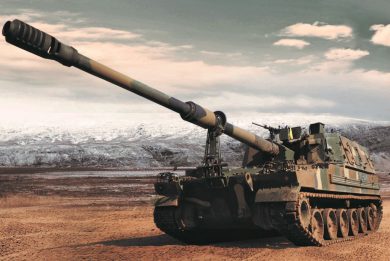
A new IFV for Egyptian mechanised units: the SENA 200
By Paolo Valpolini
Currently equipped with YPR-765 of Dutch origin and, mostly, with BMP-1S of Soviet/Russian origin, Egyptian Army mechanised infantry units should start soon receiving a nee tracked infantry fighting vehicle, the SENA 200.
Engineers at the Abu Zaabal Tank Repair Factory, which in the past produced under license the Abrams tank, have developed a new vehicle which resembles partly to the BMP-1 but has been entirely designed and developed, and is going to be produced in Egypt. Also known as Factory 200, hence the name SENA 200, the company that depends from the Ministry of Military Products worked hand in hand with the Egyptian Army Research and Development Centre. “Although we started from the BMP-1, this vehicle is totally different,” told EDR On-Line the programme manager, and has a much higher ballistic protection, not to speak about mine protection which in the Soviet vehicle was inexistent,” he added. In fact the SENA 200 has an all-round Level 4 ballistic protection according to STANAG 4579; as for RPGs, the new IFV can be fitted with stand-off nets all around, a solution not shown at EDEX, probably due also to the considerable increment in dimensions, the company booth being already overcrowded with systems. According to Factory 200, the net has an aerial density of 12 kg/m2 and ensures an 85% probability against rocket-propelled grenades; nets are produced in aramid fibres, nodes being reinforced by steel masses, a solution adopted by more than one manufacturer around the world.

As for mine protection, the company declares a Level 3, without specifying if under-track or under-belly, ground clearance being of 360 mm, blast effects on personnel being further damped by energy absorbing seats.

The driver seats at the front-left of the vehicle, with the powerplant at his right, the driving place being fitted with an NVG-compatible digital cockpit. Behind the engine compartment we find the commander, with the RCWS control console. Two rows of three centrally-mounted seats host up to six soldiers, on the vehicle exhibited at the show only four seats were installed.

Personnel is facing outside in order to be able to use individual weapons, the Egyptian doctrine maintaining the capability to fire from inside vehicles for all occupants.

Three vision blocks and firing ports per side are therefore fitted, one more being mounted in each of the two rear doors, which do not integrate a fuel tank as it was the case on the BMP.

Asked about the influence of firing ports in case of blast, the Factory 200 representative dtold EDR On-Line that those were purposely designed to avoid any effect. One rectangular hatch per side is available in the roof, very much the BMP-1 layout, a solution that should allow reducing training for those soldiers used to operate on the former-Soviet combat vehicle.
The SENA 200 has a combat weight of 14 tonnes, is 6.1 meters long, 3.04 meters wide and 1.88 meters high to the top of the vehicle. The engine provides 360 hp, which makes a power-to-weight ratio of 26 hp/t. Suspensions are based on torsion bars with shock absorbers, maximum speed on road being 65 km/h while that off-road is limited to 45 km/h, trucks being made of steel fitted with rubber pads.
Factory 200 produced the first three vehicles, the one on exhibition being fitted with the Eagle 1 RCWS from AIO, another one at the company being fitted as combat support vehicle and equipped with a one-man turret armed with 30 mm cannon, on which the company representative didn’t elaborate, adding however tht in this configuration the SENA 200 would host the driver, the commander in the turret, and two dismounts. Beside the troop carrier and fire support variants, the SENA 200 is proposed also as ambulance, missile launcher, mortar carrier, signal vehicle, command and control vehicle, ammunition carrier, logistic transporter and finally electronic warfare vehicle.
According to information available the production contract was signed, Factory 200 being currently in the production planning phase. No potential production numbers were provided.
Photos by P. Valpolini



